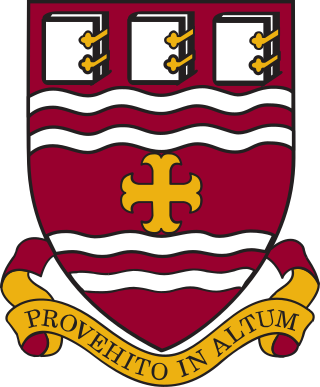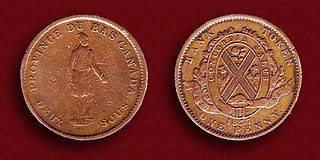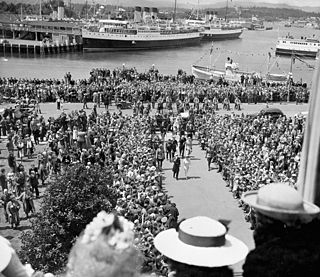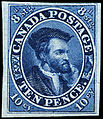
Canadian Confederation was the process by which three British North American provinces—the Province of Canada, Nova Scotia, and New Brunswick—were united into one federation called the Dominion of Canada, on July 1, 1867. Upon Confederation, Canada consisted of four provinces: Ontario and Quebec, which had been split out from the Province of Canada, and the provinces of Nova Scotia and New Brunswick. Over the years since Confederation, Canada has seen numerous territorial changes and expansions, resulting in the current number of ten provinces and three territories.

The postal and philatelic history of Canada concerns postage of the territories which have formed Canada. Before Canadian confederation, the colonies of British Columbia and Vancouver Island, Prince Edward Island, Nova Scotia, New Brunswick and Newfoundland issued stamps in their own names. The postal history falls into four major periods: French control (1604–1763), British control (1763–1841), colonial government control (1841–1867), and Canada, since 1867.

The postage stamps and postal history of British Columbia started in 1860 with the issue of a single brownish-rose stamp depicting Queen Victoria in profile and denominated as 2½ pence. It was issued jointly by Vancouver Island and British Columbia as each colony had insufficient postal trade to justify printing separate stamps. In 1862, Vancouver Island adopted decimal currency and sold the stamp for 5 cents, before issuing its own 5 and 10 cent stamps in September 1865. Meanwhile, British Columbia had increased the postal rate to 3 pence but continued to use the unified stamp. In November 1865, British Columbia issued its own stamps and the unified stamp became invalid. In 1866, the two colonies were united as British Columbia.
This is a partial timeline of significant events in postal history, including dates and events relating to postage stamps.

Memorial University of Newfoundland, also known as Memorial University or MUN, is a public research university in the province of Newfoundland and Labrador, based in St. John's, with satellite campuses in Corner Brook, elsewhere in Newfoundland and in Labrador, Saint Pierre, and Harlow, England. Memorial University offers certificate, diploma, undergraduate, graduate, and post-graduate programs, as well as online courses and degrees.

Events from the year 1865 in Canada.

Events from the year 1862 in Canada.

Events from the year 1860 in Canada.

Events from the year 1851 in Canada.

Sir Wilfred Thomason Grenfell was a British medical missionary to Newfoundland, who wrote books on his work and other topics.

St. Anthony is a town on the northern reaches of the Great Northern Peninsula of the Canadian province of Newfoundland and Labrador. St. Anthony serves as a main service centre for northern Newfoundland and southern Labrador. St. Anthony had a population of 2,180 in 2021, compared with 2,258 in 2016, 2,418 in 2011, 2,476 in 2006 and 2,730 in 2001.

The pound was the currency of the Canadas until 1858. It was subdivided into 20 shillings (s), each of 12 pence (d). In Lower Canada, the sou was used, equivalent to a halfpenny. Although the £sd accounting system had its origins in sterling, the Canadian pound was never at par with sterling's pound.

By the arrangements of the Canadian federation, the Canadian monarchy operates in Newfoundland and Labrador as the core of the province's Westminster-style parliamentary democracy. As such, the Crown within Newfoundland and Labrador's jurisdiction is referred to as the Crown in Right of Newfoundland and Labrador, His Majesty in Right of Newfoundland and Labrador, or the King in Right of Newfoundland and Labrador. The Constitution Act, 1867, however, leaves many royal duties in the province specifically assigned to the sovereign's viceroy, the lieutenant governor of Newfoundland and Labrador, whose direct participation in governance is limited by the conventional stipulations of constitutional monarchy.

The Chalon Head is the name of a number of postage stamp series whose illustration was inspired by a portrait of Queen Victoria by Alfred Edward Chalon (1780–1860).

Since 1786, members of the Canadian royal family have visited Canada, either as an official tour, a working tour, a vacation, or a period of military service. The first member to visit was the future King William IV in 1786. In 1939, King George VI became the first reigning monarch to tour the country.
Wilfred is a masculine given name derived from Germanic roots meaning "will" and "peace". The name was popular in the United Kingdom in the early twentieth century. Wilfried and its English spelling, Wilfrid, are closely related to Wilfred, with the same roots.


















